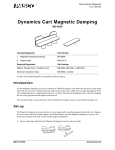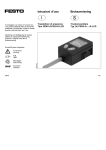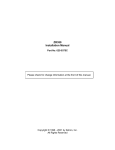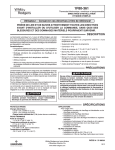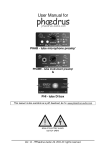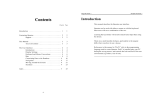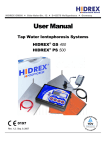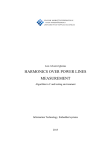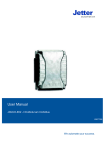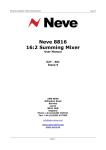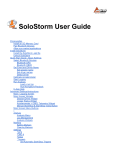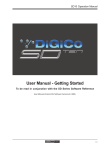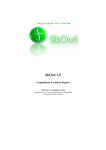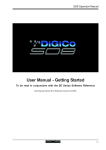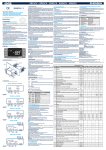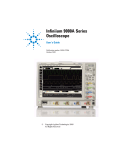Download Director - ADGIL Design
Transcript
ADGIL DESIGN Inc. 9800 series Director User Manual Oct. 2005 1 Table of Contents 1 INTRODUCTION .................................................................................................................................. 5 1.1 OVERVIEW ................................................................................................................................... 5 1.2 GLOSSARY OF ABBREVIATIONS ................................................................................................ 6 2 MAINFRAME ........................................................................................................................................ 7 2.1 REAR PANEL ................................................................................................................................ 7 2.2 I/O CARDS .................................................................................................................................... 7 2.2.1 9806 INTERFACE CARD. Slot 18. ........................................................................................ 8 2.2.2 9803A INSERT SEND CARD. Slot 11. .................................................................................... 8 2.2.3 9803A-MET METER FEED CARD. Slot 16. Optional. ............................................................ 8 2.2.4 9804A INSERT RETURN CARD. Slot 12.............................................................................. 8 2.2.5 9805C-M MASTER OUTPUT CARD. Slot 13. ........................................................................ 9 2.2.6 9805C-S SLAVE OUTPUT CARD. Slot 14............................................................................. 9 2.2.7 9808 8 CHANNEL MATRIX INPUT CARD. Slots 1 to 10........................................................10 2.2.8 9814 DOWNMIX / SOLO INPUT CARD. Slot 15. Optional. ..................................................10 2.3 FRONT PANEL .............................................................................................................................12 3 MENU SYSTEM (Release 4.XX) ..........................................................................................................13 3.1 SET UP SELECT MENU .REM. ....................................................................................................13 3.1.1 Procedure ..............................................................................................................................13 3.2 MATRIX INPUT BUSS ASSIGNMENT MENU .REM......................................................................13 3.2.1 Procedure ..............................................................................................................................14 3.3 SOURCE MENU .REM. ................................................................................................................14 3.3.1 Procedure ..............................................................................................................................14 3.4 DIM Default 18.0 dB ....................................................................................................................16 3.4.1 Procedure ..............................................................................................................................16 3.5 SPLA Default -6.000 dB ..............................................................................................................16 3.5.1 Procedure ..............................................................................................................................16 3.6 SPLB Default -12.000 dB ............................................................................................................16 3.6.1 Procedure ..............................................................................................................................16 3.7 SPLA REFERENCE Default : 85 .................................................................................................17 3.7.1 Procedure ..............................................................................................................................17 3.8 MONO INPUT .REM. ....................................................................................................................17 3.8.1 Procedure ..............................................................................................................................17 3.9 MONO OUT .REM. .......................................................................................................................17 3.9.1 Procedure ..............................................................................................................................17 3.10 EXTSOLO1 OUT .......................................................................................................................18 3.10.1 Procedure ..............................................................................................................................18 3.11 EXTSOLO1 CONTROL .............................................................................................................18 3.11.1 Procedure ..............................................................................................................................18 3.12 EXTSOLO2 OUT .......................................................................................................................18 3.12.1 Procedure ..............................................................................................................................19 3.13 EXTSOLO2 CONTROL .............................................................................................................19 3.13.1 Procedure ..............................................................................................................................19 3.14 CHANNEL ENABLE ..................................................................................................................19 3.14.1 Procedure ..............................................................................................................................19 3.15 GROUP MODE..........................................................................................................................20 3.15.1 Procedure ..............................................................................................................................20 3.16 WILD GROUP MODE ................................................................................................................20 3.16.1 Procedure ..............................................................................................................................20 3.17 GROUP ASSIGNMENT (WILD, PEC, DIR ) .REM. ....................................................................20 3.17.1 Procedure ..............................................................................................................................20 3.18 SPKRA GPI ...............................................................................................................................21 3.18.1 Procedure ..............................................................................................................................21 3.19 CUE GPI ...................................................................................................................................21 3.19.1 Procedure ..............................................................................................................................21 2 4 5 6 7 8 9 3.20 SETUP COPY MENU ................................................................................................................21 3.20.1 Procedure ..............................................................................................................................21 9840 REMOTE CONTROL...................................................................................................................22 4.1 OVERVIEW ..................................................................................................................................22 9840 REMOTE CONTROL PROGRAMMABLE FUNCTIONS...............................................................24 5.1 SOURCE AND BUSS ASSIGN .....................................................................................................24 5.1.1 Procedure ..............................................................................................................................24 5.2 MONO INPUT AND OUTPUT ASSIGN .........................................................................................24 5.2.1 Procedure ..............................................................................................................................25 5.3 MEMORY SETUP SELECTION ....................................................................................................25 5.3.1 Procedure ..............................................................................................................................25 5.4 PEC ..............................................................................................................................................26 5.4.1 Procedure ..............................................................................................................................26 5.5 DIR ...............................................................................................................................................26 5.5.1 Procedure ..............................................................................................................................26 5.6 WILD ............................................................................................................................................26 5.6.1 Procedure ..............................................................................................................................26 9840 REMOTE CONTROL FUNCTIONS .............................................................................................27 6.1 SOURCE KEYS 1 through 16........................................................................................................27 6.1.1 Selecting a source..................................................................................................................27 6.1.2 Soft grouping..........................................................................................................................27 6.1.3 Group mode enabled..............................................................................................................27 6.2 SHIFT KEY ...................................................................................................................................27 6.3 WILD KEY.....................................................................................................................................28 6.4 ENABLE KEYS .............................................................................................................................28 6.5 SPKRA Key ..................................................................................................................................28 6.6 SPKRB Key ..................................................................................................................................29 6.7 SPKRC Key ..................................................................................................................................29 6.8 MONO Key ...................................................................................................................................29 6.9 CUE Key.......................................................................................................................................29 6.10 INSERT Key ..............................................................................................................................29 6.11 CUT Key....................................................................................................................................30 6.12 DIM Key ....................................................................................................................................30 6.13 SPLA Key..................................................................................................................................30 6.14 SPLB Key..................................................................................................................................30 6.15 PEC Key....................................................................................................................................30 6.16 DIR Key.....................................................................................................................................31 6.17 INPUT LEDS .............................................................................................................................31 6.18 FINE or COARSE VOLUME CONTROL MODE .........................................................................31 INSTALLATION ...................................................................................................................................32 7.1 CONNECTING TO THE DIRECTOR ........................................................................................32 7.2 CONNECTORS ............................................................................................................................32 7.2.1 Connectors for I/O Cards 9403A, 9404A, 9805C, 9808, 9814 .................................................33 7.2.2 Connector for 9806C Interface card........................................................................................34 7.2.3 Connector for Remote Control ................................................................................................34 7.2.4 Connecting to the outside world..............................................................................................34 LEVEL CALIBRATION .........................................................................................................................36 8.1 ELECTRONIC LEVELS.................................................................................................................36 8.1.1 Procedure ..............................................................................................................................36 8.2 ACOUSTIC LEVELS .....................................................................................................................37 8.2.1 Procedure ..............................................................................................................................37 SPECIFICATIONS ...............................................................................................................................38 9.1 INPUTS ........................................................................................................................................38 9.2 OUTPUTS.....................................................................................................................................38 9.3 DYNAMIC RANGE, HEADROOM AND NOISE .............................................................................38 9.4 DIMENSIONS ...............................................................................................................................39 3 10 APPENDICES ..................................................................................................................................40 10.1 Appendix A – Block Diagram .....................................................................................................41 10.2 Appendix B – Buss amp Insert send ..........................................................................................42 10.3 Appendix C – Meter Feed ..........................................................................................................43 10.4 Appendix D – Insert Return/Mono..............................................................................................44 10.5 Appendix E – Master output.......................................................................................................45 10.6 Appendix F – Slave output .........................................................................................................46 10.7 Appendix G – Matrix Intput.........................................................................................................47 10.8 Appendix H – Downmix / Solo....................................................................................................48 Table of figures Figure 1 - Rear Panel........................................................................................................................................... 7 Figure 2 – Front Panel ....................................................................................................................................... 12 Figure 3 – Remote Control ................................................................................................................................. 23 4 1 1.1 INTRODUCTION OVERVIEW The DIRECTOR has been designed to be a multi-channel source selector and volume control for monitoring in surround. It can handle from one up to eight speaker channels, making it suitable for mono, stereo, 4 channels (LCRS), 6 channels (5.1) or 8 channels (7.1) monitoring. It has a number of functions that make it very useful in the studio and easy to interface with other equipment. While working on a specific project, the channel assignment for each piece of equipment must be determined. From that time on, and for the duration of the project, this assignment will remain the same. However, there are several standard channel assignment schemes and some non-standard as well. The input section of the DIRECTOR can be conformed to suit any format. Being a source selector and not a mixing desk, one input can only be assigned to one speaker at a time. The inputs are derived from the outputs of the various machines containing your mix elements – multitrack tapes, DAWs, etc. For example, if channel 7 of machine #2 is a LEFT channel, the corresponding input of the DIRECTOR, say input #15, will be assigned to the LEFT speaker. Inputs are selected using a SOURCE button on the remote control. A source can be any combination of inputs that must be selected together, i.e. all 6 channels of a DVD playing in a 5.1 format. The DIRECTOR allows you to have 32 different SOURCE combinations. Sometimes, it’s necessary to listen to more than one source at a time. For example, during a film mixing session, working with stems, you may want to select any one of the stems (music, dialog, effects, ambiance) alone, all together or in any combination. The DIRECTOR lets you group sources together, so that a single button may select these sources. Furthermore, any input may be part of several sources, but the channel definition (i.e. LEFT) will remain the same for all the sources using this input. All of the inputs that have been selected by the sources are mixed in eight dedicated busses: Left, Right, Center, Surround Left, Surround Right, Low Frequency Effects, Mid Left and Mid Right. The outputs of these busses are available at the Insert Send and can be used as a final mix combining the stems, or as a send to an external processor (i.e. 4 - 2 - 4 matrix for Dolby Stereo®). There are no level controls in the input section. Any selected input is routed to a buss at unity gain. The output section of the DIRECTOR lets you control the listening environment with: - Variable volume control, via a rotary shaft encoder. - Two programmable preset levels for calibrated listening. - Mute and Dim (programmable depth). - Mono check with programmable input, output and level. - Three speaker systems select: system A (multi-channel), B (stereo) or C (stereo). - Individual speaker select that can be a mute or a solo. - Selection of listening to the busses or the insert return. - External commands for Mute, Dim, Solo (AFL / PFL) from a console. There are 8 memory setups that can be programmed and stored, each one including every parameter of the DIRECTOR. They can be used to store different channel assignment schemes, listening level preferences, etc. The signal path of the DIRECTOR remains entirely analog, but is controlled by a microprocessor. Great care has been taken in its design and assembly to ensure the integrity and quality of the sound. 5 The speaker outputs are protected by relays that are activated only after the unit has stabilized following turn on, and are de-activated if any power related problem is detected. It is safe to turn the unit on or off with live speakers. The minimalist approach to signal flow, limiting the amount of electronic circuitry that a signal must go through, has led to low power consumption, allowing operation at low temperature without a fan. The power transformer is toroidal, creating extremely low acoustic and electro-magnetic radiation. Thus, this unit can be installed anywhere. The DIRECTOR has two main components: the Mainframe and the Remote Control. The chassis is a 19” rack unit, 3U high, with a Front Panel for programming, and plug-in cards in the back for the input and output connections. The remote control includes all the functions normally needed for the operation of the unit. It comes standard with a 15 m (50 ft) long cable. 1.2 GLOSSARY OF ABBREVIATIONS L R C LFE SL SR in a ML MR S Lo Ro DIR PEC DIM Left, usually Front Left Speaker. Right, usually Front Right Speaker. Center, usually Front Center Speaker. Low Frequency Effects, dedicated low frequency effects CHANNEL, also called “.1”. It is usually reproduced by a Sub-Woofer (specialized low-frequency SPEAKER). Surround Left, left half of a stereo surround system. Could also be Surround Side Left in a 5.1EX surround system. Surround Right, right half of a stereo surround system. Could also be Surround Side Right 5.1EX surround system. Mid Left, could be Inner Left in a 7.1 Film format or Surround Back Left in a 5.1EX surround system. Mid Right could be Inner Right in a 7.1 Film format or Surround Back Right in a 5.1EX surround system. Surround, Mono Surround in a L-C-R-S surround system (Dolby Stereo® or Dolby Prologic®). Left Only, left channel created by a stereo downmix of a multi-channel source. Right Only, right channel created by a stereo downmix of a multi-channel source. Direct, output of a mixing desk. Could be called “Buss” (as opposed to “Tape”) or “A” (as opposed to “B”). Photo Electric Cell, the play-back of an optical track on film. Could be called “Tape” (as opposed to “Buss”) or “B” (as opposed to “A”). Attenuation of the listening level by a preset amount, to allow for conversation or Talk-Back in the control room or studio. 6 2 MAINFRAME Figure 1 - Rear Panel 9808 9808 9808 9808 9808 9808 9808 9808 9808 9808 9803A 9804A 9805-M 9805-S 9814 9803Met Option 9806 Serial Number 1 2 3 4 5 6 7 8 9 10 11 12 13 14 15 16 17 18 Power Input, Fuse and Switch Rear View of Director 9800 2.1 REAR PANEL The DIRECTOR mainframe is based on a Euro-rack chassis. The rear panel includes 18 slots for the I/O cards. The power module, on/off switch, fuse holder and the IEC power connector are found at the extreme right. 2.2 I/O CARDS Each card has an on-board DB25 connector. The pin assignement on all cards conforms to the TASCAM DA88™ format with the exception of the 9806 Interface card. (See Section 7.2.2). Note: The input connectors on the 9804A and 9808 are female DB25 and the output connectors for 9803A, 9803A-MET, 9805C-M, 9805C-S and 9814 are male DB25. 7 2.2.1 9806 INTERFACE CARD. SLOT 18. This card is the interface between the mainframe, the remote control and the studio for all GPI and external commands (cut, solo, dim, etc.). It has an on-board DB25 connector. Refer to Section 7.2.2 for the pinout of this connector. 2.2.2 9803A INSERT SEND CARD. SLOT 11. This card includes the eight buss amplifiers. These feed 8 balanced line outputs. Multi-turn trimpots are accessible through openings in the card to calibrate the sends to your equipment. They are, from top to bottom: L, R, C, SL, SR, LFE, ML, MR. Refer to Section 7.2.2 for the pinout of this connector. OUTPUT 2.2.3 9803A-MET Channel 1: LEFT Channel 2: RIGHT Channel 3: CENTER Channel 4: SURROUND LEFT Channel 5: SURROUND RIGHT Channel 6: LFE Channel 7: MID LEFT Channel 8: MID RIGHT METER FEED CARD. SLOT 16. OPTIONAL. This card outputs eight channels of audio for metering purposes. “What you see is what you hear!”. It is the same signal that feeds the Master and Slave output cards, before level control. Refer to Section 7.2.2 for the pinout of this connector. OUTPUT 2.2.4 9804A Channel 1: Channel 2: Channel 3: Channel 4: Channel 5: Channel 6: Channel 7: Channel 8: LEFT RIGHT CENTER SURROUND LEFT SURROUND RIGHT LFE MID LEFT MID RIGHT INSERT RETURN CARD. SLOT 12. This card has 8 balanced line inputs. It also includes the mono-summing amplifier. Refer to Section 7.2.2 for the pinout of this connector. INPUT Channel 1: LEFT Channel 2: RIGHT Channel 3: CENTER Channel 4: SURROUND LEFT Channel 5: SURROUND RIGHT Channel 6: LFE Channel 7: MID LEFT Channel 8: MID RIGHT 8 2.2.5 9805C-M MASTER OUTPUT CARD. SLOT 13. The 9805C-M is the output card for the first 4 channels of your main surround speaker system (SPKR A) – outputs L, R, C and SL. It also contains two auxiliary stereo outputs (SPKR B and SPKR C). All outputs have multi-turn trimpots, accessible through openings in the card, to enable you to match levels to those of your amplifier system. They are, from top to bottom: L, R, C, SL, for speaker system A. Below the DB25 connector you will find Left, Right trimpots for speaker system B and finally, Left, Right trimpots for speaker system C. Refer to Section 7.2.2 for the pinout of this connector. OUTPUT 2.2.6 9805C-S Channel 1: SPKR A LEFT Channel 2: SPKR A RIGHT Channel 3: SPKR A CENTER Channel 4: SPKR A SURROUND LEFT Channel 5: SPKR B LEFT Channel 6: SPKR B RIGHT Channel 7: SPKR C LEFT Channel 8: SPKR C RIGHT SLAVE OUTPUT CARD. SLOT 14. The 9805C-S is the output card for the last 4 channels of your main surround speaker system (SPKR A) – outputs RS, LFE, ML, MR. All outputs have multi-turn trimpots, accessible through openings in the card, to match levels to those of your amplifier system. From top to bottom: SR, LFE, ML, MR. Refer to Section 7.2.2 for the pinout of this connector. OUTPUT Channel 1: SPKR A SURROUND RIGHT Channel 2: SPKR A LFE Channel 3: SPKR A MID LEFT Channel 4: SPKR A MID RIGHT Channel 5: NOT CONNECTED Channel 6: NOT CONNECTED Channel 7: NOT CONNECTED Channel 8: NOT CONNECTED 9 2.2.7 9808 8 CHANNEL MATRIX INPUT CARD. SLOTS 1 TO 10. The standard configuration of the DIRECTOR 9800 may include up to ten 9808 input cards. Each card has 8 balanced line inputs for a total of 80 inputs per mainframe. Refer to Section 7.2.2 for the pinout of this connector. INPUT CARD 1 Channel Channel Channel Channel Channel Channel Channel Channel CARD 2 CARD 3 CARD 4 CARD 5 CARD 6 CARD 7 CARD 8 CARD 9 CARD 10 2.2.8 9814 1: INPUT 1 2: INPUT 2 3: INPUT 3 4: INPUT 4 5: INPUT 5 6: INPUT 6 7: INPUT 7 8: INPUT 8 INPUTS 9 to 16 INPUTS 17 to 24 INPUTS 25 to 32 INPUTS 33 to 40 INPUTS 41 to 48 INPUTS 49 to 56 INPUTS 57 to 64 INPUTS 65 to 72 INPUTS 73 to 80 DOWNMIX / SOLO INPUT CARD. SLOT 15. OPTIONAL. The 9814 card is the output for the downmix and the input for the stereo solo. Refer to Section 7.2.2 for the pinout of this connector. INPUT Channel 1: LEFT, L Channel 2: RIGHT, R Channel 3: CENTER, C Channel 4: SURROUND, S (LCRS DOWNMIX) “ “ “ Channel 5: LEFT ONLY, Lo Channel 6: RIGHT ONLY, Ro (STEREO DOWNMIX) “ Channel 7: LEFT SOLO INPUT Channel 8: RIGHT SOLO INPUT 10 2.2.8.1 9814 LEVELS The Downmix levels are set by fixed resistors on the printed circuit board. They may be changed if the factory set up is not appropriate. Table 1 From channel Left Right Center Surround Left Surround Right LFE Mid Left Mid Left Mid Right Mid Right Left Right Center Center Surround Left Surround Right LFE LFE Mid Left Mid Right To L-C-R-S downmix Left Right Center Surround Surround Center Left Center Right Center To Lo-Ro downmix Resistor R1 R3 R5 R8 R10 R12 R15 R16 R18 R19 Value 10 k 10 k 10 k 14.3 k 14.3 k 10 k 16.5 k 16.5 k 16.5 k 16.5 k Gain 0 dB 0 dB 0 dB -3 dB -3 dB 0 dB -4.5 dB -4.5 dB -4.5 dB -4.5 dB Left only Right only Left only Right only Left only Right only Left only Right only Left only Right only R2 R4 R6 R7 R9 R11 R13 R14 R17 R20 10 k 10 k 16.5 k 16.5 k 10 k 10 k 16.5 k 16.5 k 10 k 10 k -3 dB -3 dB -4.5 dB -4.5 dB -3 dB -3 dB -6 dB -6 dB -3 dB -3 dB Note: the overall level of Lo-Ro output as been lowered by 3 dB to avoid clipping. 11 2.3 FRONT PANEL The front panel of the DIRECTOR mainframe has a two-line, 20 character Liquid Crystal Display (LCD). It also has switches for CUT, 4 Presets, STORE, LEFT, RIGHT, UP, DOWN and a ROTARY ENCODER. Figure 2 – Front Panel CUT SETUP 1 SETUP 2 SETUP 3 SETUP 4 STORE DIRECTOR 9800 VER. 4.12 SETUP 1, BANK 1 CUT SETUP 1 SETUP 2 SETUP 3 SETUP 4 STORE - + - + Mutes all outputs to the speaker systems, via a relay that shorts out the line. Recalls setup 1 (bank 1), or setup 5 (bank 2), from memory. Recalls setup 2 (bank 1), or setup 6 (bank 2), from memory. Recalls setup 3 (bank 1), or setup 7 (bank 2), from memory. Recalls setup 4 (bank 1), or setup 8 (bank 2), from memory. Saves any changes made to the pre-selected SETUP. Once a change has been made in any of the menus, the STORE LED will flash to indicate that the function has become active. If, at any moment you decide not to keep your changes, just press one of the four SETUP buttons to reload from that memory. Shifts the menu to the next item to the left. Shifts the menu to the next item to the right. Allows you to change the value that is shown on the LCD. Returns you to the main menu level. Sends you to the sub level menu. 12 3 MENU SYSTEM (RELEASE 4.XX) The LCD displays all user information available on the DIRECTOR system. Use the four arrow keys to navigate into the different menus or sub-menus. The ROTARY ENCODER allows you to change the value shown on the display. In this document, we will refer to these functions with symbols as well as text. Note: Some functions can be programmed from the remote control as well as from the front panel. They are identified by .REM.. Here is a list of the symbols for each function: CUT S1 SETUP 1 S2 SETUP 2 S3 SETUP 3 S4 SETUP 4 STORE RIGHT ARROW LEFT ARROW UP ARROW DOWN ARROW ROTARY ENCODER 3.1 SET UP SELECT MENU .REM. The DIRECTOR has eight presets. Use this menu to select one of two banks, of four presets each, with the ROTARY ENCODER. Bank 1: memory preset 1-2-3-4. Bank 2: memory preset 5-6-7-8. 3.1.1 PROCEDURE Turn the ROTARY ENCODER to the desired bank Press STORE to keep this setting. Note: After selecting the appropriate bank, you can step through the different memory presets using the four setup keys on the front panel. 3.2 MATRIX INPUT BUSS ASSIGNMENT MENU .REM. Use this menu to assign the inputs from the 9808 cards to a specific output buss. One input can only be assigned to one buss at a time. 13 3.2.1 PROCEDURE Turn the ROTARY ENCODER to the appropriate input (1 to 80). press the DOWN ARROW key to go to the sub menu. Turn the ROTARY ENCODER to the appropriate BUSS selection (LEFT, RIGHT, CENTER, SURLEFT, SURRIGHT, SUB, MIDLEFT, MIDRIGHT). Press STORE to keep this setting. Use the UP ARROW to select the main input menu. Turn the ROTARY ENCODER to the appropriate input. Press the DOWN ARROW key to go to the sub menu. Turn the ROTARY ENCODER to the appropriate BUSS selection. Press STORE to keep this setting. Repeat this procedure for all inputs. Note: The system shows you the card number on the menu (9808 # 2). The input number corresponds to the cards that are configured in your system. EXAMPLE: 3.3 Input 1 to 8 = Card 1 input 1 to 8. Input 9 to16 = Card 2 input 1 to 8. Input 17 to 24 = Card 3 input 1 to 8. Input 25 to 32 = Card 4 input 1 to 8. Input 33 to 40 = Card 5 input 1 to 8. Input 41 to 48 = Card 6 input 1 to 8. Input 49 to 54 = Card 7 input 1 to 8. Input 55 to 64 = Card 8 input 1 to 8. Input 65 to 72 = Card 9 input 1 to 8. Input 73 to 80 = Card 10 input 1 to 8. SOURCE MENU .REM. Use this menu to assign one or more inputs to a SOURCE button on the remote. A SOURCE is a group of inputs that are selected together when a source key is selected on the remote control. The corresponding LED for that source will be lit. The SOURCE may have any number of inputs assigned to it, up to the total number of inputs in the system (80 max.). The input LED on the left side of the 9840 remote will indicate which inputs are selected at any time. 3.3.1 PROCEDURE Turn the ROTARY ENCODER to the appropriate SOURCE. (SOURCE = 01 to 32 plus WILD ) press the DOWN ARROW key to go to the sub menu. CLEAR ALL INPUTS = NO Turn the ROTARY ENCODER to yes. (ONLY IF YOU WANT TO CLEAR ALL INPUTS SELECTED BY THAT SOURCE) Press STORE to clear the inputs. Use the RIGHT ARROW to select the INPUT SELECTION MENU (IN XX = OFF, ON). Turn the ROTARY ENCODER to the appropriate input. ( IN = XX ) Press STORE to toggle the inputs to ON or OFF. Turn the ROTARY ENCODER to the next input to be selected or deselected.( IN = XX ) Press STORE to toggle the inputs to ON or OFF. Repeat this procedure for all inputs that are selected by that source. 14 Press the UP ARROW key to go to the main menu. Turn the ROTARY ENCODER to the appropriate source. Repeat the whole procedure for all 32 sources plus the WILD. 3.3.1.1 SOURCE ASSIGNMENT MENU EXAMPLE A SOURCE is a group of inputs that work together, for example the 6 channels of the mixing desk in a 5.1 configuration. A source can select up to 80 inputs. EXAMPLE: you have three 9808 input cards and you would like to have four 5.1 sources. The assignment could look like this: SOURCE 01 BUSS ASSIGNMENT SOURCE ASSIGNMENT 9808 card 01- CH1 : INPUT 01 = LEFT INPUT 01 = ON 9808 card 01- CH2 : INPUT 02 = RIGHT INPUT 02 = ON 9808 card 01- CH3 : INPUT 03 = CENTER INPUT 03 = ON 9808 card 01- CH4 : INPUT 04 = SUR LEFT INPUT 04 = ON 9808 card 01- CH5 : INPUT 05 = SUR RIGHT INPUT 05 = ON 9808 card 01- CH6 : INPUT 06 = SUB INPUT 06 = ON All remaining inputs on SOURCE 01 = OFF SOURCE 02 BUSS ASSIGNMENT SOURCE ASSIGNMENT 9808 card 01- CH7 : INPUT 07 = LEFT INPUT 07 = ON 9808 card 01- CH8 : INPUT 08 = RIGHT INPUT 08 = ON 9808 card 02- CH1 : INPUT 09 = CENTER INPUT 09 = ON 9808 card 02- CH2 : INPUT 10 = SUR LEFT INPUT 10 = ON 9808 card 02- CH3 : INPUT 11 = SUR RIGHT INPUT 11 = ON 9808 card 02- CH4 : INPUT 12 = SUB INPUT 12 = ON All remaining inputs on SOURCE 02 = OFF SOURCE 03 BUSS ASSIGNMENT SOURCE ASSIGNMENT 9808 card 02- CH5 : INPUT 13 = LEFT INPUT 13 = ON 9808 card 02- CH6 : INPUT 14 = RIGHT INPUT 14 = ON 9808 card 02- CH7 : INPUT 15 = CENTER INPUT 15 = ON 9808 card 02- CH8 : INPUT 16 = SUR LEFT INPUT 16 = ON 9808 card 03- CH1 : INPUT 17 = SUR RIGHT INPUT 17 = ON 9808 card 03- CH2 : INPUT 18 = SUB INPUT 18 = ON All remaining inputs on SOURCE 03 = OFF SOURCE 04 BUSS ASSIGNMENT SOURCE ASSIGNMENT 9808 card 03- CH3 : INPUT 19 = LEFT INPUT 19 = ON 9808 card 03- CH4 : INPUT 20 = RIGHT INPUT 20 = ON 9808 card 03- CH5 : INPUT 21 = CENTER INPUT 21 = ON 9808 card 03- CH6 : INPUT 22 = SUR LEFT INPUT 22 = ON 9808 card 03- CH7 : INPUT 23 = SUR RIGHT INPUT 23 = ON 9808 card 03- CH8 : INPUT 24 = SUB INPUT 24 = ON All remaining inputs on SOURCE 04 = OFF 15 Selecting SOURCE 1 on the remote would enable the first 6 channels of CARD 01 and send the audio signals to their respective speaker outputs. Selecting SOURCE 2 on the remote would enable the last 2 channels of CARD 01 and the first 4 channels of CARD 02 and send the audio signals to their respective speaker outputs. Selecting SOURCE 3 on the remote would enable the last 4 channels of CARD 02 and the first 2 channels of CARD 03 and send the audio signals to their respective speaker outputs. Selecting SOURCE 4 on the remote would enable the last 6 channels of CARD 03 and send the audio signals to their respective speaker outputs. 3.4 DIM DEFAULT 18.0 DB Programmable DIM, adjustable from 0.000 dB to Mute in increments of .375 dB. 3.4.1 PROCEDURE Turn the ROTARY ENCODER to the appropriate dim value. (DIM = - 18.000 dB) Press STORE to keep the value in memory. 3.5 SPLA DEFAULT -6.000 DB Programmable SPLA adjustable from 0.000 dB to Mute in increments of .375 dB. Note: The level control works as an attenuator with taps every 0.375dB. SPLA is a programmed tap on the ladder. 3.5.1 PROCEDURE Turn the ROTARY ENCODER to the appropriate value. (SPLA = -6.000 dB) Press STORE to keep the reference in memory. 3.6 SPLB DEFAULT -12.000 DB Programmable SPLB adjustable from 0.000 dB to Mute in increments of .375 dB. Note: Like SPLA, SPLB is a tap on the ladder. 3.6.1 PROCEDURE Turn the ROTARY ENCODER to the appropriate value. (SPLB = -12.000 dB) Press STORE to keep the reference in memory. 16 3.7 SPLA REFERENCE DEFAULT : 85 Once you have adjusted your DIRECTOR to a certain SPL level for SPLA, you can display that level on the 9840 Remote control by selecting it in this menu. Note: This display is an indication only. It is not a measure of the actual level in the studio. 3.7.1 PROCEDURE Turn the ROTARY ENCODER to the appropriate reference. ( SPLA REF = 60 to 140 dB ) Press STORE to keep the reference in memory. 3.8 MONO INPUT .REM. Selects which busses that are sent to the mono summing amplifier. 3.8.1 PROCEDURE Press the DOWN ARROW key to go to the sub menu. (LEFT = NO) Turn the ROTARY ENCODER to YES or NO. (YES enables the left channel in the mono sum, NO disables it). Press STORE to keep the new setting. Use the RIGHT ARROW to select the next buss to be sent to the mono sum. (RIGHT = NO) Turn the ROTARY ENCODER to YES or NO. (YES enables the right channel in the mono sum, NO disables it.) Press STORE to keep the new setting. Repeat this procedure for all the busses. Press the UP ARROW key to go to the main menu. 3.9 MONO OUT .REM. Selects how the mono sum will be heard. It can be sent to the Left Speaker, the Right Speaker or the Center Speaker. 3.9.1 PROCEDURE Press the DOWN ARROW key to go to the sub menu. (CENTER = NO) Turn the ROTARY ENCODER to YES or NO. (YES enables the mono sum to the center speaker, NO disables it). Press STORE to keep the new setting. Use the RIGHT ARROW to select the next output for the mono sum. (LEFT = NO) Turn the ROTARY ENCODER to YES or NO. (YES enables the mono signal to the left speaker, NO disables it). Press STORE to keep the new setting. Use the RIGHT ARROW to select the next output for the mono sum. (RIGHT = NO) Turn the ROTARY ENCODER to YES or NO. (YES enables the mono signal to the right speaker, NO disables it). Press STORE to keep the new setting. 17 Press the UP ARROW key to go to the main menu. Note: If the mono sum is sent to L and R, the level will be lowered by 6 dB in each channel to maintain the overall level. Note: If the mono sum is sent to C, this sum will go to the center speaker if SPKR A (surround) is selected. If SPKR B or C (stereo) is selected, the mono sum will go to L-R regardless of the mono out selection. 3.10 EXTSOLO1 OUT Selects how the stereo solo signal will be heard when EXTSOLO1 GPI is activated. Note: The solo is a stereo signal. However, it can be summed to mono and assigned to the center speaker if you desire. 3.10.1 PROCEDURE Press the DOWN ARROW key to go to the sub menu. (LEFT = NO) Turn the ROTARY ENCODER to YES or NO. (YES enables the left solo signal to the left speaker, NO disables it). Press STORE to keep the new setting. Use the RIGHT ARROW to select the next output for the solo signal. (RIGHT = NO) Turn the ROTARY ENCODER to YES or NO. (YES enables the right solo signal to the right speaker, NO disables it). Press STORE to keep the new setting. Use the RIGHT ARROW to select the next output for the mono sum. (L+R>CENTER = NO) Turn the ROTARY ENCODER to YES or NO. (YES enables the left and right solo signals to the center speaker, NO disables them). Press STORE to keep the new setting. Press the UP ARROW key to go to the main menu. Note: If the mono sum is sent to C, this sum will go to the center speaker if SPKR A (surround) is selected. If SPKR B or C (stereo) is selected, the mono sum will go to L-R regardless of the mono out selection. 3.11 EXTSOLO1 CONTROL Enables or disables activation of the solo input mode by an external control. Refer to the GPI section for more information on the external GPI configuration. 3.11.1 PROCEDURE Turn the ROTARY ENCODER to YES or NO. (YES enables the external solo1 control signal to be active, NO disables it). Press STORE to keep the new setting. 3.12 EXTSOLO2 OUT Selects how the stereo solo signal will be heard when EXTSOLO2 GPI is activated. 18 3.12.1 PROCEDURE Press the DOWN ARROW key to go to the sub menu. (LEFT = NO) Turn the ROTARY ENCODER to YES or NO. (YES enables the left solo signal to the left speaker, NO disables it). Press STORE to keep the new setting. Use the RIGHT ARROW to select the next output for the solo signal. (RIGHT = NO) Turn the ROTARY ENCODER to YES or NO. (YES enables the right solo signal to the right speaker, NO disables it). Press STORE to keep the new setting. Use the RIGHT ARROW to select the next output for the mono sum. (L+R>CENTER = NO) Turn the ROTARY ENCODER to YES or NO. (YES enables the left and right solo signals to the center speaker, NO disables them). Press STORE to keep the new setting. Press the UP ARROW key to go to the main menu. Note: If the mono sum is sent to C, this sum will go to the center speaker if SPKR A (surround) is selected. If SPKR B or C (stereo) is selected, the mono sum will go to L-R regardless of the mono out selection. 3.13 EXTSOLO2 CONTROL Enables or disables activation of the solo input mode by an external control. Refer to the GPI section for more information on the external GPI configuration. 3.13.1 PROCEDURE Turn the ROTARY ENCODER to YES or NO. (YES enables the external solo1 control signal to be active, NO disables it). Press STORE to keep the new setting. Note: EXTSOLO2 control and output assign are an exact duplicate of the EXTSOLO1. It provides a second control to be used in the case of a dual console operation, allowing separate solo functions. EXTSOLO2 shares the audio input signals with EXTSOLO1, only the controls are different. 3.14 CHANNEL ENABLE Sets the channel enable buttons on the remote to a SOLO or a MUTE type action. If SOLO mode is active, depressing one of the channel enable keys will mute all channels except the one selected. If MUTE mode is selected, depressing one of the channel enable keys on the remote will mute that particular channel only. 3.14.1 PROCEDURE Turn the ROTARY ENCODER to SOLO or MUTE. (MODE = XXXX ) Press STORE to keep the new setting. 19 3.15 GROUP MODE If the GROUP MODE is enabled, you have access the “soft grouping” from the source keys on the remote. When you are not in GROUP MODE, the source keys will toggle ON and OFF when activated. The GROUP MODE only applies to the source keys; PEC, DIR and WILD will retain their respective operating modes. 3.15.1 PROCEDURE Turn the ROTARY ENCODER to yes or no. (YES enables the group mode, NO disables it). Press STORE to keep the new setting. 3.16 WILD GROUP MODE If the wild group is enabled, the WILD key on the remote can be used as a group master, just like PEC or DIR. When the wild group is disabled, the WILD key is used as a normal source that can be toggled on and off from the regular source selection. Refer to Section 6.3 for how to use the WILD key. 3.16.1 PROCEDURE Turn the ROTARY ENCODER to yes or no. (YES enables the wild group, NO disable it). Press STORE to keep the new setting. 3.17 GROUP ASSIGNMENT (WILD, PEC, DIR ) .REM. Sources can be grouped together and the resulting group can be selected using one of the GROUP keys (PEC, DIR, WILD). 3.17.1 PROCEDURE Turn the ROTARY ENCODER to the appropriate source. (01 to 32) Press the DOWN ARROW key to go to the sub menu. (WILD = ON, OFF) Turn the ROTARY ENCODER to ON or OFF. Press STORE to keep the new setting. Use the RIGHT ARROW to select the PEC group. (PEC = ON, OFF) Turn the ROTARY ENCODER to ON or OFF. Press STORE to keep the new setting. Use the RIGHT ARROW to select the DIR group. (DIR = ON, OFF) Turn the ROTARY ENCODER to ON or OFF. Press STORE to keep the new setting. Press the UP ARROW key to go to the main menu. Turn the ROTARY ENCODER to the next source. Repeat this procedure for all sources that need to be assigned to a group. 20 3.18 SPKRA GPI Enables or disables the corresponding GPI output. If enabled, depressing the SPKRA key on the remote will send a pulse to the SPKRA GPI; depressing SPKRB or SPKRC will send a pulse on SPKRB-C GPI. This can be used to switch an external matrix (i.e. DOLBY SDU4™, from LCRS to stereo and back) automatically when switching from a multi-channel speaker system to a stereo speaker system. 3.18.1 PROCEDURE Turn the ROTARY ENCODER to yes or no. (YES enables the GPI, NO disables it). Press STORE to keep the new setting. 3.19 CUE GPI Sets the mode of the GPI output to a momentary or a toggle type of action. The CUE LED on the remote shows the state of the CUE GPI. 3.19.1 PROCEDURE Turn the ROTARY ENCODER to MOMENT or TOGGLE. Press STORE to keep the new setting. Note: The CUE has no action on the DIRECTOR. It is just a GPI. 3.20 SETUP COPY MENU Use this menu to copy a memory setup to any other memory setup (other than itself). 3.20.1 PROCEDURE Press the down arrow key to go to the sub menu. (FROM SETUP 1) Turn the ROTARY ENCODER to the appropriate source memory setup. Use the RIGHT ARROW to select the destination submenu. (TO SETUP 2) Turn the ROTARY ENCODER to the appropriate destination memory. Use the RIGHT ARROW to select the confirm submenu. Turn the ROTARY ENCODER to confirm. (YES, NO) Press STORE to keep the new setting and initiate the copy. Wait until the memory is copied. Repeat this procedure if necessary. 21 4 4.1 9840 REMOTE CONTROL OVERVIEW The 9840 remote control is the operator’s interface. It has all necessary controls and indicators normally required in the course of a session. The left-hand side has LED indicators, showing which inputs are in use. This is pa rticularly useful when many inputs or combinations of sources are selected. At the bottom left, there is a 4 digit alphanumeric display, giving relevant information according to the mode the remote control is in. It normally displays the monitoring level, as set by SPLA REF and the position of the tap on the attenuator ladder. In a programming mode, it will prompt you as to what is being programmed. The top two rows of switches are the SOURCE select switches. In combination with the SHIFT key, these switches give access to the 32 sources. The switches on the third row are the CHANNEL ENABLE keys. These can be either MUTE or SOLO for the individual speaker channels. The fourth row has various functions, such as CUE, SPEAKER SYSTEM SELECT, MONO, INSERT, WILD group and SHIFT. The switches on the left-hand side of the bottom row deal with listening levels, including CUT, DIM, SPLA and SPLB. Next to them is a rotary shaft encoder that serves a number of functions on the DIRECTOR. This ROTARY ENCODER is normally the variable volume control for the speakers, but it becomes a selector in programming mode. The switches on the right of the ROTARY ENCODER control the PEC and DIR groups. 22 Figure 3 – Remote Control 1234 5678 9 - - 12 13 - - 16 17 - - 20 21 - -24 S O U R C E 1-17 2-18 3-19 4-20 5-21 6-22 7-23 8-24 9-25 10-26 11-27 12-28 13-29 14-30 15-31 16-32 L C R SL SR LFE ML MR CUE SPKR A SPKR B SPKR C MONO INSERT WILD SHIFT 25 - - 28 29 - - 32 33 - - 36 37 - - 40 41 - - 44 45 - - 48 49 - - 52 53 - - 56 E N A B L E 57 - - 60 61 - - 64 P R O G 65 - - 68 69 - - 72 73 - - 76 77 - - 80 85.0 CUT ADGIL DIM SPL A SPL B PEC CONTROL ROOM DIR 9840 23 5 9840 REMOTE CONTROL PROGRAMMABLE FUNCTIONS The 9840 remote control gives you access to the programming features of the DIRECTOR that are used during a session. Note: While programming the MONO mix or the sources, the DIRECTOR will remain active for some of the functions like CUE, SPKRA, SPKRB, SPKRC, SPLA, SPLB and INSERT so you can continue monitoring while programming. 5.1 SOURCE AND BUSS ASSIGN This function enables you to assign any number of INPUTS to a SOURCE and lets you change the BUSS assignment of an INPUT. 5.1.1 PROCEDURE - Select a SOURCE by pressing on any of the 32 source keys or the WILD key. - While keeping that SOURCE key depressed, toggle the SHIFT key once. - Release the SOURCE key and the SHIFT key. - The SHIFT key LED will be flashing, indicating programming mode. The SOURCE key LED will be flashing, indicating which source is being programmed. - The alpha-numeric display shows “IN 01” and input 1 on the 80 LED column is flashing. - If any of the 80 inputs is associated with that SOURCE it will be shown on the 80 LED column. - The assignment of INPUT 01 is shown on the 8 LEDs of the ENABLE switches. - A flashing LED means that the INPUT is not associated with the selected SOURCE, but is assigned to that BUS. - A LED that is on means that the INPUT is associated with this SOURCE and assigned to that BUS. - To toggle the status of this INPUT, press on the ENABLE key that is lit (deselects the input from the source), or flashing (selects the input into that source and keeping the input assignement), or unlit (selects the input into the source and changing the input assignement). IMPORTANT NOTE: You can change the BUSS assignment by selecting a different ENABLE key than the one that is active (flashing or on), but remember that each input can only be assigned to one BUSS at a time. If you change the BUSS assignment of an input, it will be changed for all the SOURCES that use this input. - Use the ROTARY ENCODER to select another input and repeat the operation for all the inputs that you want assigned to that SOURCE. - To end the source programming mode press any of the SOURCE keys or the SHIFT key. 5.2 MONO INPUT AND OUTPUT ASSIGN This function enables you to assign any of the 8 BUSSES to the MONO mix and lets you redirect the output of the MONO signal to the left, right or center speaker. 24 5.2.1 PROCEDURE - Press and hold the MONO key. - Toggle the SHIFT key once. - Release the MONO key and the shift key. The SHIFT key LED will be flashing, indicating programming mode. The MONO key LED will be flashing, indicating that mono is being programmed. - The display shows “M in” (Mono buss inputs). - The 8 LEDs of the ENABLE switches will be on or flashing. - A flashing LED means that the BUSS is not being sent to the MONO mix. - A solidly lit LED means that the BUSS is being sent to the MONO mix. - To toggle the status of the BUSS assignment to the MONO mix, press on the ENABLE key that is on or flashing. - Turn the ROTARY ENCODER to the right to select the MONO output. - The display shows “M out” (Mono output). - To toggle the status of the output assignement of the MONO mix, press on the ENABLE key that is lit or flashing. - To end the source-programming mode, select any of the SOURCE keys, the SHIFT key or the MONO key. Note: The Mono mix can be assigned to SPKR L, R or C in a multi speaker setup. If speaker B or C is selected, the Mono mix will always go to L + R regardless of the output assignment. 5.3 MEMORY SETUP SELECTION This function lets you select eight different memory setups (1 to 8). 5.3.1 PROCEDURE - Press and hold the CUT key. - Toggle the SHIFT key once. - Release the CUT key and the SHIFT key. - Only the SHIFT key LED will be flashing. - The display shows “SETx” (x = 1 to 8). - Turn the ROTARY ENCODER to the new memory setup (1 to 8) that is to be selected. - The only key that will save the new setup selection is the SHIFT KEY. - ANY OTHER KEY WILL RELEASE YOU FROM THE MEMORY SETUP MENU WITHOUT CHANGES. Note: This function is the same as the one found on the front panel (SETUP 1 through 4 and bank selection). 25 5.4 PEC PEC is the select key for the PEC GROUP. 5.4.1 PROCEDURE - Press and hold the PEC key. - Toggle the SHIFT key once. - The PEC key LED is flashing, as well as the SHIFT key LED. - Release both the PEC and the SHIFT keys. - Select the SOURCES that are to be part of the PEC group using the SOURCE keys. Press again to deselect. - Once a SOURCE has been selected, its LED will remain ON indicating that it is is part of the group. - Press the PEC key to exit the programming mode. 5.5 DIR DIR is the select key for the DIR GROUP. 5.5.1 PROCEDURE - Press and hold the DIR key. - Toggle the SHIFT key once. - The DIR key LED is flashing, as well as the SHIFT key LED. - Release both the DIR and the SHIFT keys. - Select the SOURCES that are to be part of the DIR group using the SOURCE keys. Press again to deselect. - Once a SOURCE has been selected, its LED will remain ON indicating that it is is part of the group. - Press the DIR key to exit the programming mode. 5.6 WILD Depending on the WILD GROUP MODE (front panel programming), the WILD key can be used to select either a SOURCE which toggles on and off, or a GROUP. 5.6.1 PROCEDURE If the WILD group mode is on: - Press and hold the WILD key. - Toggle the SOURCE keys to select or de-select from the group. The SHIFT key remains active to give access to sources 17 to 32 - Release the WILD key. Once the WILD key is a group master, depressing on it will select or de-select the group of sources assigned to it. When the group is de-selected only the WILD source will remain active with the input selection that you have made in the source menu (WILD is the last source to be programmed in the menu, after source 32). 26 6 6.1 6.1.1 9840 REMOTE CONTROL FUNCTIONS SOURCE KEYS 1 THROUGH 16. SELECTING A SOURCE To select a source you have to press the button corresponding to that source. For example, selecting SOURCE1 on the remote would enable the inputs that have been preconfigured in the source menu. EXAMPLE: Selecting SOURCE1 would enable the first six inputs of card one and send these inputs to the busses that have been selected in the buss assignment menu. SOURCE 01 BUSS ASSIGNEMENT SOURCE ASSIGNEMENT 9808 card 01- CH1 : INPUT 01 = LEFT INPUT 01 = ON 9808 card 01- CH2 : INPUT 02 = RIGHT INPUT 02 = ON 9808 card 01- CH3 : INPUT 03 = CENTER INPUT 03 = ON 9808 card 01- CH4 : INPUT 04 = SUR LEFT INPUT 04 = ON 9808 card 01- CH5 : INPUT 05 = SUR RIGHT INPUT 05 = ON 9808 card 01- CH6 : INPUT 06 = LFE INPUT 06 = ON All remaining INPUTS on SOURCE 01 = OFF 6.1.2 SOFT GROUPING - GROUP MODE ENABLED To select multiple sources in the soft grouping mode, all you have to do is hold down one of the source keys and press the other sources to select or de-select them. As long as you have one of the source keys selected, you can continue selecting or de-selecting sources. If you have selected multiple sources, the first source key you selected has become your group master. To select or de-select the whole group, all you have to do is to press that first source key. 6.1.3 GROUP MODE DISABLED If the GROUP MODE is DISABLED the source key will only toggle that source on and off when depressed, it has no effect on other sources. WARNING: If you are in GROUP DISABLED mode, the soft grouping selection is disabled. LED STATUS: ON: Source is selected OFF: Source is muted Note: There is always at least one source selected at any time. Should you want to have no signal in the busses, or insert sends, select a source that has no input assigned to it. 6.2 SHIFT KEY Selecting the SHIFT key will bring you to the second bank of sources (17 to 32). The same instructions apply to both the shifted bank and the non-shifted bank. (Refer to the source key paragraph for information on how to use the sources). 27 LED STATUS: ON: Shift bank is selected (source 17 to 32). OFF: Shift bank is not selected (source 1 to 16). Note: There is at least one source selected at any time. When you select the shifted bank for the first time, there will be no source selected in that bank (all source LEDs blank), but the previous source selection is still active. The previous bank selection will be de-activated the moment you select a new source in the shifted bank. WARNING: You cannot make any source selection if you keep the shift key depressed. 6.3 WILD KEY The WILD key gives access to two different functions, depending on the selected WILD group mode. If the WILD group mode is ON, the WILD key will behave like the other group masters (PEC and DIR). If the WILD group mode is OFF, the WILD key will behave like a SOURCE, but this source will toggle on and off when selected, without any effect on the other sources. The other sources will have no effect on the WILD source either. This function is really useful in ADR, when music, ambiances and sound effects have to be brought in and out without deselecting the dialogs. LED STATUS: ON: Wild source is selected OFF: Wild source is muted Note: When you assign sources to the WILD key in GROUP MODE the SHIFT key remains active so that you can select both banks of sources. 6.4 ENABLE KEYS These keys can function as either MUTE or SOLO for the individual speaker channels. The mode selection is programmed from the front panel of the DIRECTOR. LED STATUS: ON: Channel is enabled FLASH: Channel is muted OFF: Channel is disabled (i.e. There is no input routed to that channel). Note: Mute turns off only the selected channel, the others are untouched. Solo mutes all other channels, leaving the selected one untouched. It is possible to mute or solo more than one channel at a time. 6.5 SPKRA KEY Selects the multi-channel speaker system A. LED STATUS: ON: Speaker system A is selected. OFF: Speaker A is not selected. 28 6.6 SPKRB KEY Selects the stereo speaker system B. Note: if you have a dual multi-channel DIRECTOR system, SPKRB will select the second multichannel speaker system. LED STATUS: ON: Speaker system B is selected. OFF: Speaker system B is not selected. 6.7 SPKRC KEY Selects the stereo speaker system C. LED STATUS: ON: Speaker system C is selected. OFF: Speaker system C is not selected. 6.8 MONO KEY Selects or de-selects the software pre-configured mono source and sends it to the software preconfigured speaker output. LED STATUS: ON: The MONO function is active FLASH: The external SOLO signal is active OFF: The MONO function is inactive Note: The inputs and outputs are pre-selected in the mono-in and mono-out menu on the front panel of the DIRECTOR. The MONO source has its level stored in memory. This can be modified by turning the ROTARY ENCODER while keeping the MONO key depressed. The level will show on the display from 0.1 to 12.0. This level has approximately 18 dB of range and is not a calibrated level. 6.9 CUE KEY This key triggers the CUE GPI output. Momentary or toggle action, as selected in the CUE GPI menu on the front panel of the DIRECTOR . LED STATUS: ON: The Cue GPI open collector output is active. OFF: The Cue GPI open collector output is not active. 6.10 INSERT KEY This key selects the signal sent to speakers and meters. LED STATUS: ON: The signal from the 9804 insert return card is selected. OFF: The signal from the 9803 buss amplifier card is selected. 29 6.11 CUT KEY This key mutes all speaker outputs. LED STATUS: ON: All speaker systems are muted. FLASH: All speaker systems are muted by an external cut control signal. OFF: All selected speaker systems are unmuted. Note: This is an electronic switch, as opposed to the CUT switch on the front panel of the mainframe that activates a relay on the output of the unit for speaker protection. 6.12 DIM KEY This key dims all speaker systems by a pre-selected amount. This amount can be adjusted in the DIM menu on the front panel of the DIRECTOR. LED STATUS: ON: All speaker systems are dimmed. FLASH: All speaker systems are dimmed by an external dim control signal. OFF: All selected speaker systems are not dimmed. 6.13 SPLA KEY This key sets the output to a pre-selected level. This level can be adjusted in the SPLA menu on the front panel of the DIRECTOR . LED STATUS: ON: The level of the system matches the SPLA level. OFF: The level of the system does not match the SPLA level. 6.14 SPLB KEY This key sets the output to a pre-selected level. This level can be adjusted in the SPLB menu on the front panel of the DIRECTOR . LED STATUS: ON: The level of the system matches the SPLB level. OFF: The level of the system does not match the SPLB level. Note: When the SPLA or SPLB levels are attained, the corresponding LED will be active on the remote. If neither of the two LEDS is on, then the system is not at either SPLA or SPLB. 6.15 PEC KEY This key selects the sources assigned to the PEC group. LED STATUS: ON: PEC is selected. OFF: PEC is not selected. 30 6.16 DIR KEY This key selects the sources assigned to the DIR group. LED STATUS: ON: DIR is selected. OFF: DIR is not selected. 6.17 INPUT LEDS The 80 LED display on the left side of the 9840 remote will reflect the status of the inputs. If an input is selected, the corresponding led will be lit. 6.18 FINE OR COARSE VOLUME CONTROL MODE To toggle the volume control mode (fine = 0.375 db/step or coarse = 4.5 db/step) press on the speaker switch that is already selected. Example: SPKRA is selected, depressing the SPKRA switch once will select the coarse adjustment and depressing it once again will select the fine adjustment. If you switch between speaker systems, the DIRECTOR will retain the last volume mode that was selected. 31 7 7.1 INSTALLATION CONNECTING TO THE DIRECTOR Connect your console or sound source outputs to the 9808 Matrix Input cards of the DIRECTOR . Connect the 9805C Master and Slave output cards cards to your power amplifiers. If you have any equipment that normally functions as an insert, connect it to the 9803A Insert Send card and the 9804A Insert Return card to the output of that equipment. Connect the 9840 Remote Control to the 9806 Interface card using the provided cable. 7.2 CONNECTORS All connectors on the cards are type DB25. Female connectors are used for the audio inputs and male connectors for the outputs. These connectors follow the standard pinout configuration used for the TASCAM DA88™ series. The 9806 interface card is NOT used for audio interconnection and does not follow this convention. The connector on the remote control is a type DB9, male. 32 7.2.1 9814 CONNECTORS FOR I/O CARDS 9803A,9803A-MET, 9804A, 9805C-M, 9805C-S, 9808, 7.2.1.1 PINOUT OF THE DB25 AUDIO CONNECTORS 1 - CHANNEL 8 HOT 2 - SHIELD 3 - CHANNEL 7 COLD 4 - CHANNEL 6 HOT 5 - SHIELD 6 - CHANNEL 5 COLD 7 - CHANNEL 4 HOT 8 - SHIELD 9 - CHANNEL 3 COLD 10 - CHANNEL 2 HOT 11 - SHIELD 12 - CHANNEL 1 COLD 13 - SHIELD 14 - CHANNEL 8 COLD 15 - CHANNEL 7 HOT 16 - SHIELD 17 - CHANNEL 6 COLD 18 - CHANNEL 5 HOT 19 - SHIELD 20 - CHANNEL 4 COLD 21 - CHANNEL 3 HOT 22 - SHIELD 23 - CHANNEL 2 COLD 24 - CHANNEL 1 HOT 25 - SHIELD Note: The shields are all internally connected to the chassis via the panel on each card. 7.2.1.2 Audio connections L R C SL SR LFE ML MR S Lo Ro Card DB25 9803A male 9803A-MET male 9804 female 9805-M male 9805-S male 9808 female 9814 male Left Front. Right Front. Center Front. Surround Left. Surround Right. Low Frequency Effects. Mid Left, either Inner Left in a 7.1 system or Surround Back Left in a 5.1 EX system. Mid Right, either Inner Right in a 7.1 system or Surround Back Right in a 5.1 EX system. Surround, Surround output of the LCRS downmix. Left only, Left output of the stereo downmix. Right only, Right output of the stereo downmix. In/Out Out Out In Out Out In Out/In Ch 1 L L L A-L A-SR 1 L Out Ch 2 R R R A-R A-LFE 2 R Out Ch 3 C C C A-C A-ML 3 C Out Ch 4 SL SL SL A-SL A-MR 4 S Out Ch 5 Ch 6 Ch 7 Ch 8 SR LFE ML MR SR LFE ML MR SR LFE ML MR B-L B-R C-L C-R 5 6 7 8 Lo Out Ro Out Solo L In Solo R In 33 7.2.2 CONNECTOR FOR 9806C INTERFACE CARD The 9806C is a microprocessor control card that provides an interface between the outside world (GPI connections), the remote control, the front panel and all the audio cards in the chassis. 7.2.2.1 PINOUT OF FEMALE DB25 1 - DIGITAL GND 2 - DIGITAL GND 3 - RS422 RECEIVE 4 - RS422 TRANSMIT 5 - REMOTE ENABLE INPUT 6 - +10 VOLT FUSED AT 250ma. 7 - DIR LED OUTPUT 8 - DIR PADDLE SWITCH INPUT 9 - SPKRA GPI OUTPUT 10 - TALK GPI OUTPUT 11 - EXT SOLO1 CTRL INPUT 12 - EXT DIM CTRL INPUT 13 - DIGITAL GND SHELL - CHASSIS GND 14 15 16 17 18 19 20 21 22 23 24 25 - +10 VOLT (Current limited 270 ma.) - +10 VOLT (Current limited 270 ma.) - RS422 RECEIVE + - RS422 TRANSMIT + - NOT CONNECTED - NOT CONNECTED - PEC LED OUTPUT - PEC PADDLE SWITCH INPUT - SPKRBC GPI OUTPUT - CUE GPI OUTPUT - EXT CUT CTRL INPUT - EXT SOLO2 CTRL INPUT Pins 1 to 6 and 14 to 17 are used to connect to the 9840 Remote Control, via a provided 50’ cable (Canare A2C3). The other pins can be used to connect to external commands and indicators. Note: RS422 Transmit and Receive signal are those from the 9806C Card point of view. 7.2.3 CONNECTOR FOR THE REMOTE CONTROL 7.2.3.1 PINOUT OF MALE DB9 1 - DIGITAL GND 2 - DIGITAL GND 3 - RS422 RECEIVE 4 - RS422 TRANSMIT 5 - REMOTE ENABLE INPUT SHELL - CHASSIS GND 7.2.4 6 - +10 VOLT (Current limited 270 ma.) 7 - +10 VOLT (Current limited 270 ma.) 8 - RS422 RECEIVE + 9 - RS422 TRANSMIT + CONNECTING TO EXTERNAL CONTROLS AND INDICATORS Pins 6 to 13 and 20 to 25 of the DB25 on the 9806C interface card are used to interface with external commands and indicators in the studio. A +10V, unregulated supply, fused at 250 mA, is available if needed. The reference for all controls and indicators is the DIGITAL GND. 34 7.2.4.1 Pins 6 to 13 6. +10V. Unregulated supply, fused at 250 mA. 7. DIR LED OUTPUT. TTL level (+5 volt), active high, driven through a 300-ohm resistor to drive a LED directly. The LED is on when the DIR group is active. 8. DIR PADDLE SWITCH INPUT. Logic active-low, diode protected input. A logic low applied to this pin will select the DIR group and de-select all other active groups or sources. 9. SPKRA GPI OUTPUT. Open collector output. Pulse. Provided to switch an external unit requiring switching when the multi-channel speaker system is selected (i.e. DOLBY SURROUND DECODER SDU-4™). See SPKRBC GPI to select a stereo setup. 10. Talk GPI Output. Open collector output. This function is not currently implemented. 11. EXT SOLO1 CTRL INPUT. Logic active-low, diode protected input. A logic low applied to this pin will select the stereo solo input instead of the remote selected sources. This control is only active if you have the EXTSOLO1 CTRL enabled in the menu. You must have the 9814 Downmix/Solo-in card installed to be able to route the Solo audio signal to the speaker system. When an external solo control signal is active, the LED on the MONO key will flash on the remote. 12. EXT DIM CTRL INPUT. Logic active-low, diode protected input. A logic low applied to this pin will dim all the speaker systems by the pre-selected dim amount. When an external dim control signal is active, the LED of the DIM key will flash on the remote. 13. DIGITAL GND. The reference for all switches and LEDs. Return for the +10 V. 7.2.4.2 Pins 20 to 25 20. PEC LED OUTPUT. TTL level (+5 volt), active high, driven through a 300-ohm resistor to drive an LED directly. The LED is on when the PEC group is active. 21. PEC PADDLE SWITCH INPUT. Logic active-low, diode protected input. A logic low applied to this pin will select the PEC group and de-select all other active groups or sources. 22. SPKRBC GPI OUTPUT. Open collector output. Pulse. Provided to switch an external unit requiring switching when one of the stereo speaker system (B or C) is selected (i.e. DOLBY SURROUND DECODER SDU-4™). See SPKRA GPI to select a multi-channel setup. 23. CUE GPI OUTPUT. Open collector output. It provides an output to interface with an external cue signal (red light, cue light, etc.). 24. EXT CUT CTRL INPUT. Logic active-low, diode protected, input. A logic low applied to this pin will mute all the speaker systems. When an external cut control signal is active, the CUT key LED will flash on the remote. 25. EXT SOLO2 CTRL INPUT. Logic active-low, diode protected input. A logic low applied to this pin will select the stereo solo input instead of the remote selected sources. This control is only active if you have the EXTSOLO2 CTRL enabled in the menu. You must have the 9814 Downmix/Solo-in card installed to be able to route the Solo audio signal to the speaker system. When an external solo control signal is active, the LED on the MONO key will flash on the remote. 35 8 LEVEL CALIBRATION The DIRECTOR is designed to handle maximum levels of +28 dBu at any input, +28 dBu at the Insert send and +22 dBu at the speaker output. In order to optimize both headroom and noise performance, it is important to calibrate levels properly. Notes: 1) The operating level of all sources should be identical to provide consistent acoustical levels when switching from one source to the other. 2) If several sources are selected simultaneously, the combined level will rise, diminishing the headroom at an average rate of 3 dB every time you double the number of sources. 3) Most power amplifiers are capable of providing full power (clipping) with audio levels in the range of 0 to +8 dBu (peak levels, not average operating levels). 4) The DIRECTOR is built using 1% resistors. The channel -to-channel gain variations are minimal. 8.1 8.1.1 ELECTRONIC LEVELS PROCEDURE Values in brackets [xxx] are the factory default and probably a good starting point for your setup. 1) 2) 3) 4) 5) 6) 7) 8) 9) 10) 11) 12) 13) 14) Turn your amplifiers or speakers off. Decide on the nominal operating level for the studio [0 VU = +4 dBu]. Apply this level [Sine wave at 1 kHz] to one input [1]. Route this input to a buss [L]. Measure the level of that buss at the Insert Send point, with its nominal load attached. Adjust for nominal level [+4 dBu], using the multiturn trimmer at the back of the 9803A card. If your system has a 9803A-MET meter output card, trim the output [L] with its own trimmer. Route the input [1] to another buss [R] and repeat steps 5 to 7 for that buss (and meter). Repeat for every other buss (and meter). Select Speaker A with the remote control and turn the listening level to the maximum, using the ROTARY ENCODER. Apply the test signal [1 kHz, +4 dBu] to one input [1] and route this input to one output [L]. On the 9805C-M card (Master Output), adjust A-L trimpot for the desired level [0 dBu] at Speaker A Left Output. Route the Input to R output and adjust A-R (Speaker A Right Output) for the same level as A-L. Repeat steps 11 and 12 for all the outputs (A-C, A-SL, A-SR, A-LFE, A-ML, A-MR, B-L, B-R, C-L, C-R). 36 8.2 ACOUSTIC LEVELS You will need a Sound Level Meter (SLM) with C-weighting and a slow reading characteristic to calibrate the system acoustically. In a room designed for critical listening, it is of the utmost importance to know the nominal listening levels. Once the acoustic calibration has been completed, the digital readout on the remote control will display the actual listening levels in the room. (In the following procedure, the values in square brackets [xxx] are examples of the nominal levels used in a film mixing theater.) Notes: 1) Only LEVELS may be calibrated with the DIRECTOR, not EQ. 2) The SPL display on the 9840 remote control [85] is just an indication that reflects what the level would be if a Pink Noise, at nominal level [0 VU], was sent to one channel [L]. 8.2.1 PROCEDURE 1) Determine the nominal listening level [85 dBC, slow reading, pink noise in one channel]. This will become SPL-A. (See ITU, ISO-2969 or Dolby recommendations). Determine how much headroom is needed [20 dB]. Determine what the alternate listening level should be [79 dBC, slow]. This will become SPL-B. Decide how much extra gain you may want to apply to your listening program material [6 dB], to check for background noise, for example. Go to the menu on the front panel, called SPL-A. Turn the front panel ROTARY ENCODER until the display reads [-6.000] dB (the extra gain above normal listening level, as defined in step 4). Save that level. Go the menu on the front panel, called “SPLA Reference”. Turn the ROTARY ENCODER until the display reads the value for your nominal listening level [85]. Save that level. Go to the menu called “SPL-B”. Turn the ROTARY ENCODER until the display reads the alternate listening level [-12.000, 6 dB below SPL-A]. Save that level. Select SPL-A on the remote control, remove any MUTE or DIM. Turn the speakers or amplifiers ON with the level control on the amps turned down. Route a pink noise at nominal level [0 VU] to one speaker [L]. Turn the gain control up on the power amplifier, or the speaker, until the SLM reads your nominal listening level [85 dBC, slow]. If the power amplifiers do not have a volume control, the trimpots on the 9805C cards may be used, thus changing the calibration in steps 12 to 14 of the electronic calibration procedure. Repeat the previous two steps for the other speakers in the system. Verify that your desired headroom is preserved, including equalization if present. 2) 3) 4) 5) 6) 7) 8) 9) 10) 11) 12) 13) 14) 15) 16) 17) 18) 19) 37 9 SPECIFICATIONS For the following specifications, unless otherwise specified, the test signals used were sine wave tones. The reference level is +4 dBu = 1.228 Vrms. Tests were performed using an AUDIO PRECISION PORTABLE ONE™ test set, with one source selected, SPKRA, SPLA = - 6.000 dB, +4 dBu IN = -6 dBu OUT. 9.1 INPUTS Max input level (any input) Impedance CMRR (typical) 9.2 9.3 +28 dBu. 20 kΩbal, I0 kΩto ground per leg. 80 dB @ 100 Hz. 78 dB @ 1 kHz. 60 dB @ 20 kHz. OUTPUTS Max output level +28 dBu, 10 kΩload at INSERT SEND. +22 dBu, 10 kΩload at SPKR output. Output noise -96 dBu un-weighted, 22 Hz-22 kHz. -99 dBu A-weighted. Output bandwidth -0.2 dB @ 10 Hz, -3 dB @ 70 kHz, ref. 1 kHz. Output distortion 0.004 % THD+N, from 10 Hz to 30 kHz. Crosstalk L - R -110 dB @ 20 Hz. -93 dB @ 1 kHz. -65 dB @ 20 kHz. DYNAMIC RANGE, HEADROOM AND NOISE Keeping adequate headroom, while preserving a low noise floor, may be an interesting exercise. The following table shows values in a DIRECTOR , measured with an AUDIO PRECISION PORTABLE ONE™. One Input [1] is routed to one buss [L], with settings at nominal. Measured at L Out Insert Send Speaker A Out Signal Level [dBu] +4.00 -6.00 Clipping [dBu] +28.0 +22.0 Headroom [dB] 24.0 28.0 Noise Floor [dBu, 20Hz-20kHz] -98.0 -97.0 Dynamic Range [dB] 126 119 38 9.4 DIMENSIONS Weight: 7 kg (15 lbs). Chassis: 19" x 3U: 480 x 133 x 260 mm (19” x 5.25" x 10.25"). Remote control: 210 x 152 x 51 mm (8.25" x 6" x 2") Supply: 117 V or 230 V AC +/- 15%, 50/60Hz, 25VA average, fused @ 1 Amp S.B. 39 10 APPENDICES 10.1 A: BLOCK DIAGRAM 10.2 B: BUSS AMP / INSERT SEND 10.3 C: METER FEED 10.4 D: INSERT RETURN / MONO MIX 10.5 E: MASTER OUTPUT 10.6 F: SLAVE OUTPUT 10.7 G: MATRIX INPUT 10.8 H: DOWNMIX / SOLO IN 10.9 I: STUDIO INTEGRATION EXAMPLE 10.10 J: CONFIGURATION AS SHIPPED 40 APPENDIX A – BLOCK DIAGRAM 41 10.11 APPENDIX B – BUSS AMP / INSERT SEND 42 10.12 APPENDIX C – METER FEED 43 10.13 APPENDIX D – INSERT RETURN / MONO MIX 44 10.14 APPENDIX E – MASTER OUTPUT 45 10.15 APPENDIX F – SLAVE OUTPUT 46 10.16 APPENDIX G – MATRIX INTPUT 47 10.17 APPENDIX H – DOWNMIX / SOLO 48
















































